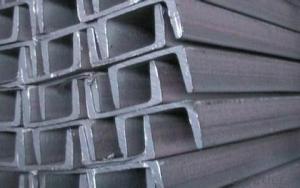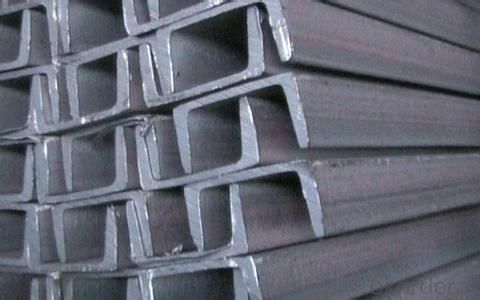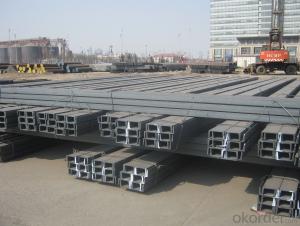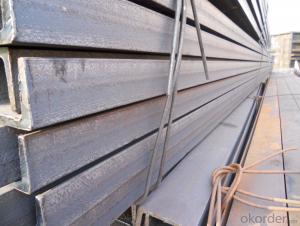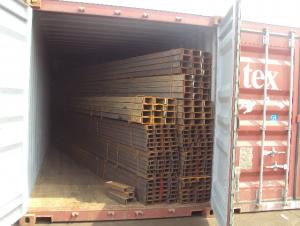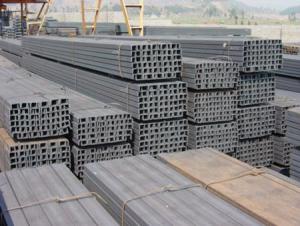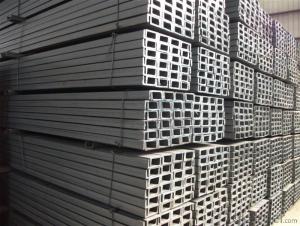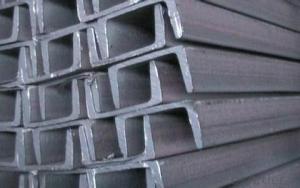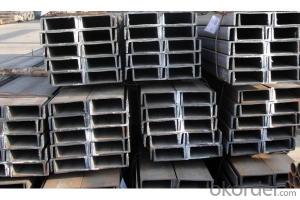steel channel GB;channel beam
- Loading Port:
- Tianjin
- Payment Terms:
- TT OR LC
- Min Order Qty:
- 1000 m.t.
- Supply Capability:
- 3000 m.t./month
OKorder Service Pledge
OKorder Financial Service
You Might Also Like
Product Description:
Specifications of Channel Steel:
| Original Place | Tangshan, China | Brand Name | Bridge |
| Standard | GB707-88, EN100025, JIS G3192, DIN 1026 | ||
| Sizes | 50mm to 300mm | ||
| Sales Volume/Year | 3000MT | ||
| Main Market | Middle East, Africa, Southeast As | ||
1.We are able to provide channel steel of top quality at attractive price.
2.Our products of channel steel have passed ISO9001:2008 Quality Management System Certification.
3. The section of JIS Standard Channel Steel are as followings in the table.
| JIS U CHANNEL | Standard h | Sectional b | Dimension s | t | Mass: Kg/m |
| (mm) | (mm) | (mm) | (mm) | ||
| 50x25 | 50 | 25 | 3.0 | 6.00 | 2.37 |
| 75X40 | 75 | 40 | 3.8 | 7.00 | 5.30 |
| 75X40 | 75 | 40 | 4.0 | 7.00 | 5.60 |
| 75X40 | 75 | 40 | 4.5 | 7.00 | 5.85 |
| 75X40 | 75 | 40 | 5.0 | 7.00 | 6.92 |
| 100X50 | 100 | 50 | 3.8 | 6.00 | 7.30 |
| 100X50 | 100 | 50 | 4.2 | 6.00 | 8.03 |
| 100X50 | 100 | 50 | 4.5 | 7.50 | 8.97 |
| 100X50 | 100 | 50 | 5.0 | 7.50 | 9.36 |
| 125X65 | 125 | 65 | 5.2 | 6.80 | 11.66 |
| 125X65 | 125 | 65 | 5.3 | 6.80 | 12.17 |
| 125X65 | 125 | 65 | 5.5 | 8.00 | 12.91 |
| 125X65 | 125 | 65 | 6.0 | 8.00 | 13.40 |
| 150x75 | 150 | 75 | 5.5 | 7.30 | 14.66 |
| 150x75 | 150 | 75 | 5.7 | 10.00 | 16.71 |
| 150x75 | 150 | 75 | 6.0 | 10.00 | 17.90 |
| 150x75 | 150 | 75 | 6.5 | 10.00 | 18.60 |
4. Chemical Compostion of JIS Standard Channel Steel
| Grade | Element(%) | |||
| C | Mn | P | S | |
| SS330 | -- | -- | ≦0.050 | ≦0.050 |
| SS400 | ||||
| SS490 | ||||
| SS540 | ≦0.30 | ≦1.60 | ≦0.040 | ≦0.040 |
Usage/Applications of Channel Steel:
Channel Steel is usually used for building structure, vehicle manufacturing and other industrial structure and often used with i beam.
In details, the channel steel belongs to carbon structural steel which is applied to in the field of construction and machinery. The channel steel is usually used for arch-itechtural structure, and they could be welded in order to support or hang a vari-ety of facilities. They are also usually used in combination with I beam. Generally,the channel steel must possess perfect welding property, riveting property and mechanical property and so on.
Package & Delivery of Channel Steel:
The steel u channel will be packed in bundle with steel wire at each end of every bundle and color marking in order to help the customer to recognize his goods more easily at sight.
And steel u channel could be loaded into 20ft or 40ft container, or by bulk cargo. If the weight of each bundle reaches less than 3.5 mt, the loading by break bulk cargo should be choosed. When the weight of each bundle reaches less than 3mt, the loading by container should be choosed.
As for the transportaion from mill to loading port, the truck will be usually used. And the maximum quantity for each truck is 40mt.
All in all, we could do in accordance with customer's request.
- Q: How are steel channels used in the construction of hospitals or healthcare facilities?
- Steel channels are used in the construction of hospitals or healthcare facilities to provide structural support and reinforcement. They are commonly used in the framing of walls, ceilings, and floors, ensuring the stability and durability of the building. Steel channels also play a vital role in the installation of electrical and plumbing systems, as they provide a secure pathway for wiring and piping. Additionally, they are utilized for mounting equipment, such as medical gas lines or HVAC units, ensuring efficient operation and maintenance of the facility.
- Q: Can steel channels be used in the manufacturing industry?
- Yes, steel channels can be used in the manufacturing industry. Steel channels are commonly used in various manufacturing processes due to their versatility, durability, and strength. They are primarily used for structural support, such as in the construction of buildings, bridges, and industrial equipment. Steel channels can also be used as framing components in the manufacturing of vehicles, machinery, and appliances. Additionally, they can serve as tracks, guides, or rails in material handling systems and conveyor belts. The manufacturing industry often relies on steel channels for their ability to withstand heavy loads and provide stability, making them an essential component in many manufacturing applications.
- Q: Are steel channels suitable for the mining industry?
- Yes, steel channels are commonly used in the mining industry due to their numerous qualities and suitability for various applications. Steel channels are known for their strength, durability, and resistance to wear and tear, making them ideal for the harsh and demanding conditions found in mining operations. Steel channels are often used in the construction of infrastructure within mines, such as support structures, walkways, platforms, and conveyors. Their ability to withstand heavy loads and provide stability makes them a reliable choice for these applications. Additionally, steel channels can be easily welded, allowing for efficient installation and customization to meet specific mining requirements. Furthermore, steel channels offer excellent corrosion resistance, which is crucial in mining environments where exposure to moisture, chemicals, and other corrosive substances is common. This resistance ensures the longevity of the equipment and structures used in mining operations, reducing maintenance costs and downtime. Another advantage of steel channels is their versatility. They come in a variety of sizes and shapes, allowing for flexible designs and configurations that can be adapted to different mining applications. Steel channels can also be galvanized or coated to provide additional protection against corrosion or environmental factors. In summary, steel channels are highly suitable for the mining industry due to their strength, durability, resistance to corrosion, and versatility. Their use in various mining applications enhances safety, efficiency, and longevity, making them an integral part of the industry's infrastructure.
- Q: How do steel channels contribute to daylighting in buildings?
- Enhanced daylighting in buildings can be achieved with the help of steel channels. These channels serve as a supportive framework for large windows or skylights, enabling architects and engineers to create expansive openings in walls or roofs. This design choice allows abundant natural light to permeate deep into the interior spaces of a building. Moreover, these channels are designed to withstand the loads imposed by the windows or skylights, ensuring their stability and long-lasting performance. In addition to their structural support, steel channels can also be utilized to develop innovative daylighting systems, such as light shelves or light tubes. These systems effectively distribute natural light throughout the building, further enhancing the overall daylighting experience. The use of steel channels in buildings is pivotal in maximizing daylighting, enhancing the quality of indoor spaces, reducing reliance on artificial lighting, and promoting energy efficiency.
- Q: Are steel channels suitable for use in conveyor systems?
- Yes, steel channels are suitable for use in conveyor systems. Steel channels provide strong structural support and are highly durable, making them ideal for use in heavy-duty applications such as conveyor systems. They can withstand heavy loads and can be easily customized to fit specific conveyor requirements. Additionally, steel channels have excellent resistance to wear, corrosion, and temperature fluctuations, ensuring prolonged and reliable performance in conveyor systems.
- Q: Can steel channels be used for creating support structures for ventilation systems?
- Yes, steel channels can be used for creating support structures for ventilation systems. Steel channels are known for their strength and durability, making them suitable for providing the necessary support for ventilation systems. They can effectively hold the weight of the ductwork and ensure stability and longevity of the system.
- Q: What are the different types of connections for steel channels in modular office systems?
- Steel channels in modular office systems can be connected using various methods to ensure stability and structural integrity. One widely used method is the bolted connection, which involves securing the steel channels together using bolts. These bolts are inserted through pre-drilled holes in the channels and then tightened with nuts. Bolted connections are relatively simple to install and offer a strong and dependable connection. Another option is the welded connection, which involves melting the metal at the connection points and allowing it to solidify, thereby joining the steel channels together. Welded connections are highly durable and provide exceptional strength. However, they require skilled labor and specialized equipment to be properly executed. A third alternative is the riveted connection, where rivets are used to secure the steel channels together. The rivets are inserted through pre-drilled holes in the channels and then deformed to hold them in place. Riveted connections are known for their ability to carry heavy loads and resist vibrations. However, they may be more time-consuming to install compared to bolted connections. Additionally, adhesive connections can also be used. This method involves using high-strength adhesives to bond the steel channels together. Adhesive connections are often used in combination with other connection methods to provide additional stability. They are particularly useful when drilling or welding is not feasible or desirable. To summarize, the available connection options for steel channels in modular office systems include bolted connections, welded connections, riveted connections, and adhesive connections. Each method has its own advantages and considerations, and the choice will depend on factors such as load requirements, installation limitations, and budget constraints.
- Q: Can steel channels be used for overhead door framing?
- Yes, steel channels can be used for overhead door framing. Steel channels are often used in construction for their strength and durability, making them suitable for supporting the weight and movement of overhead doors.
- Q: What are the different load distribution techniques for steel channels in roof systems?
- Some of the different load distribution techniques for steel channels in roof systems include using purlins or trusses to evenly distribute the weight of the roof, employing structural bracing to provide additional support, and incorporating proper connections and fasteners to ensure stability and load sharing across the channels.
- Q: Can steel channels be used for support columns?
- Yes, steel channels can be used for support columns. Steel channels are commonly used in construction for various structural applications, including supporting columns. They are known for their strength and durability, making them ideal for bearing heavy loads and providing structural support. Additionally, steel channels can be easily fabricated and installed, making them a popular choice for support columns in both commercial and residential buildings.
Send your message to us
steel channel GB;channel beam
- Loading Port:
- Tianjin
- Payment Terms:
- TT OR LC
- Min Order Qty:
- 1000 m.t.
- Supply Capability:
- 3000 m.t./month
OKorder Service Pledge
OKorder Financial Service
Similar products
Hot products
Hot Searches
Related keywords
